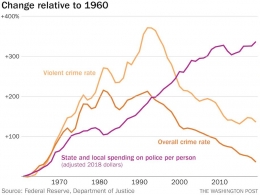Additionally, reallocation of police budgets would translate to a decrease in policing activities. Consequently, it is theorised that police disinvestment could lead to an escalation in the number of crimes committed. Active acts of policing (frequent patrols, etc) increases the perceived strength of police (Corman & Mocan, 2000) through increasing the perceived certainty and severity of punishments.
This chain of interlinking perceptions would ultimately diminish the number of offenses committed as most potential offenders would be deterred from committing such foul acts of crime. This “deterrence hypothesis” is based on the assumption that individual-level perceptions of crime is greatly determined by macro-level deviations in policing activities such as an increase in patrols and arrests.
Potential offenders would refrain from committing criminal offenses as they perceive themselves as more susceptible to arrests and legal actions due to the perceived increase in police strength (Marvell & Moody, 1996).
Disinvestment would instead decrease the resources available to execute escalating or at the very least constant amounts of policing activities and would in turn result in an increase in criminal offenses due to the decreased deterrence effects felt by potential offenders.

Notwithstanding the theoretical doubts, empirical studies have shown that an increase in police funding does not acquaint to decreased crime rates. A glance at the general trend of police per capita expenditure and the crime rate does not display the hypothesized consistent, negative correlation.
Per capita police expenditures have escalated from 1980 to 2010 while crime rates exhibit an inverted U-shape growth curve, declining from the early 1990s onwards. The incoherence in the growth patterns can be observed in recent years. During a five year period between 2006 until 2010, state and local police per capita expenditures increased from $386 to $412. On the contrary, the crime rate per 100,000 plummeted during the same five year period from 3800 to 3350 crimes reported.
However, as can be observed from the graph above, the year 2012 saw an end to the negative relationship between the two variables as police expenditure per capita plummeted to $389 while the drop in crime rates per 100,000 stayed persistent as the statistic dropped to 3256 crimes. Statistical analysis as elaborated above demonstrates the non-existent correlation between the two variables.
Proponents of police divestment recognize a plethora of potentially more advantageous ways to utilize the funds otherwise “wasted” on excessive police funding.
Due to their sizable budgets, police officers are socially obliged to accomplish duties of which are not inherently their own. For instance, police spend an estimate of 21% of their time to respond to issues regarding mental illness, an issue which police officers are not equipped to resolve.
This issue can partly be attributed to the lack of mental health professionals available to be dispatched to deal with such issues. Therefore, allocating an increasingly large amount towards social necessities such as mental health professionals would be better suited to quench those needs.








